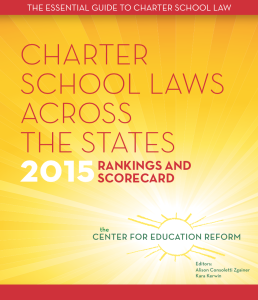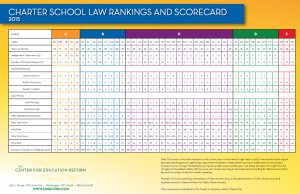by Yaël Ossowski
Watchdog
April 28, 2015
At the recent Education Writers Association national seminar in Chicago, a small breakout session asked the following question: Is school choice a tool for opportunity and equity, or further segregation?
Following the latest negative spin on charter schools around the country, it seems most education journalists decidedly choose the latter.
“If you’re an education writer and aren’t covering segregation in schools, I’d ask you why,” said Nikole Hannah-Jones, winner of the EWA award for best education reporting, in her acceptance speech.
Her comments echo the controversial study released by Duke University researchers in conjunction with the National Bureau of Economic Research earlier this month, which claims charter schools in North Carolina are further segregating public schools and leaving minority students behind.
The Washington Post says this is proof white parents are using charter schools to “secede” from the traditional public system. But the figures show otherwise.
According to Watchdog.org reporter Moriah Costa’s report on Washington, D.C. schools, charter schools in the nation’s capital have 78 percent black students, a full 10 percent ahead of normal public schools.
And it’s not just in Washington, D.C.
The Center for Education Reform’s 2014 Charter School Survey finds charter schools serve more low-income students, more black and Hispanic students.
“Charter students are somewhat more likely to qualify for Free and Reduced Lunch due to being low-income (63 percent of charter students versus 48 percent of public school students), to being African-American (28 percent of charter students versus 16 percent of public school students) or to being Hispanic (28 percent of charter students versus 23 percent of public school students),” says the study.
Even applied locally, charter schools provide more academic results to a more diverse student body.
A March 2015 study from the Center for Research on Education Outcomes, an institute hosted at Stanford University, examined 41 different metropolitan school districts and recorded a higher level of academic growth in kids who attend charter schools.
“Our findings show urban charter schools in the aggregate provide significantly higher levels of annual growth in both math and reading compared to their traditional public school peers,” claims the study.
That includes metros such as Atlanta, Boston, Chicago, Denver, Detroit, Indianapolis, Memphis, Milwaukee, Minneapolis, New Orleans, Phoenix and Washington, D.C.
“Across all urban regions, Black students in poverty receive the equivalent of 59 days of additional learning in math and 44 days of additional learning in reading compared to their peers in traditional public schools,” write the authors.
That’s 48 extra days of math learning and 25 additional days of reading learning for Hispanic students.
In a provocative 2009 study, entitled “Do charter schools ‘cream skim’ students and increase racial-ethnic segregation?”, researchers from Mathematica Policy Research at Vanderbilt University couldn’t document any proof of segregation in charter schools.
“We find little evidence that charter schools are systematically creating greater segregation,” said the researchers. In addition, they found that students who transfer to charter schools receive better test scores once they begin in their new schools, not before.
That puts down the claim that charter schools are only recruiting amongst the best students and leaving poor-performing kids behind, a charge often cited by public school activists and teachers unions.
The most vociferous reactions to the claims of charter school segregation have come from black leaders in the charter school movement.
“Nonsense,” said David Hardy, CEO of Boys Latin of Philadelphia Charter. “Poor public schools do more to increase segregation than any charter,” he told Watchdog.org. Hardy’s school population is made up of approximately 97 percent black students.
Darrell Allison, president of Parents for Educational Freedom, a North Carolina-based charter school organization, blasted the claims as “false and disingenuous.” He points to figures which show charter schools in the Tar Heel State have a student population with over 30 percent while traditional public schools have only 26 percent.
Considering the facts, the notion that charter schools are further segregating minority students seems to be without support. Whether that will inform the arguments of charter school and school choice opponents is still to be determined.
Watchdog.org reporters Evan Grossman, Moriah Costa, Mary Tillotson, and Paul Brennan contributed to this report.














Maryland Students Deserve a Break
by Jeanne Allen
When governors win historic elections, one expects legislators to not only respect such a mandate but to try to work collaborate on changes that help those for whom adults should work the hardest, and that’s our kids. Such expectations for Maryland, however, seem sadly out of reach right now. This week, the Maryland Senate Education, Health & Environmental Affairs Committee took up Governor Larry Hogan’s very modest proposal to amend the state’s charter school law, in order to increase quality educational opportunities for students who currently have no options other than their assigned school, which may not fit their needs. Yet rather than even debate the need for more and better choices, this allegedly thoughtful body ignored his proposals altogether and actually took action to make Maryland’s education law less accountable to parents and taxpayers! They did so by removing the advisory role of the State Board of Education and by taking any authority away from charter school principals to choose their own staff!
This was news to many legislators with whom advocates spoke this week. Indeed even the Governor’s own staff seems to believe that they have made progress. That’s because there has been little time given to actually understanding how charter school laws are supposed to work and a lot of time given to listening to mythology and misinformation about this very successful education reform that has helped 42 other states and The District of Columbia transform schooling for all types of children, particularly the poor and disadvantaged among us.
The reality is that a charter school law that permits school districts to dictate the terms under when and how a new public school is formed and control all of its hiring, curriculum decisions and funding is not a charter school law at all. It’s simply a suggestion that school boards consider doing things a little differently, if they want. The problem is that while well meaning individuals run and win school board elections all the time, just being a board member, or hiring smart people to run a district, doesn’t make them education experts. Experts are the teachers who have trained and studied what works for children, the principals who can show accomplishment with the least well-off students and those with the most complications, and the parents closest to the kids who may not know about teaching school stuff but certainly know what works best for their kids.
This is the genesis of charter schooling, and it is the reason thousands of ordinary people across the state were buoyed by Larry Hogan’s promise when he ran for office to improve the state’s education system so that all children, not just those fortunate to live in good school communities, can have access to better education. In fact, Governor Hogan has affirmed time and time again that he won’t accept a bill that rolls back the clock, and that provides no additional support for families who struggle to do the right thing for their kids. That’s why many are mystified that many alleged charter supporters claim that recent action is a step forward, when it is definitely many steps back.
They may not understand that there is data to support the development of strong laws; data that shows student achievement is strong in strong law states. Strong charter school laws give teachers the freedom to negotiate their own contracts with the charter school governing board, and they establish fair and equitable funding. Equally important is the need to alleviate the potential for arbitrary and capricious decisions by some school districts that don’t understand or are afraid of change by allowing charter applications to be reviewed by the State Board of Education on appeal.
Either Maryland has to go forward or stop and engage in a factual discussion about how various provisions in law result in various practices. Doing nothing is better than doing something bad, particularly when the record is clear that this Legislature will never permit this issue to be brought up again once it has had its day in the state house. Maryland may be unique, but lessons learned from other states and communities are powerful guides for the future. Staying the course is not acceptable. Moving backwards is insane. Citizens must hold their government to account for its legislative and spending decisions and give Maryland students a break. The best and most immediate way to do that is to enact a new charter law, now.
Jeanne Allen is Senior Fellow and president emeritus of The Center for Education Reform.